In the late nineteenth and early twentieth centuries Fort Worth’s mass transit needs were served by several competing streetcar companies in addition to the interurban to Dallas and to Cleburne. Such mass transit was popular at a time when most people did not own an automobile. To encourage folks to ride the rails these companies built “trolley parks” on their lines. These parks were the Six Flags Over Texases and Disney Worlds of their day: popular destinations for families, lodges, unions, companies, and public school classes.
For a brief time early in the twentieth century, Fort Worth had four trolley parks. The first was Pavilion Park (also called “Rosedale Pavilion”) on Samuels Avenue (1885-1907), opened by the Rosedale streetcar company to anchor the northern end of its line, which ran south to the Missouri Pacific Infirmary. Next came Lake Como in Arlington Heights in 1890, Lake Erie in Handley in 1903, and White City on the North Side in 1906.
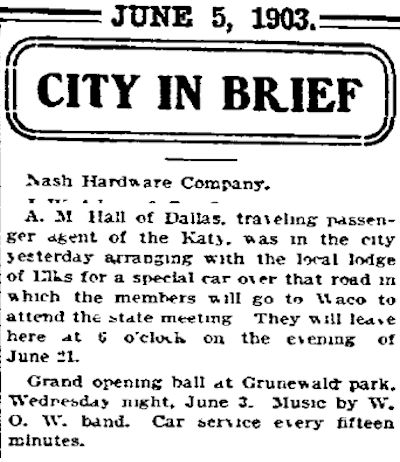 By the early twentieth century Fort Worth’s first trolley park, Rosedale Pavilion, was called “Grunewald Park.” Owner Peter Grunewald did not advertise much in local newspapers, but his grand opening ball of the 1903 season did get into the Fort Worth Telegram’s daily column “City in Brief,” which contained as many ads as news items. The running ad for Nash Hardware Company did not even get a complete sentence. Charles E. Nash probably paid to have his company’s name appear at the top of the column each day.
By the early twentieth century Fort Worth’s first trolley park, Rosedale Pavilion, was called “Grunewald Park.” Owner Peter Grunewald did not advertise much in local newspapers, but his grand opening ball of the 1903 season did get into the Fort Worth Telegram’s daily column “City in Brief,” which contained as many ads as news items. The running ad for Nash Hardware Company did not even get a complete sentence. Charles E. Nash probably paid to have his company’s name appear at the top of the column each day.
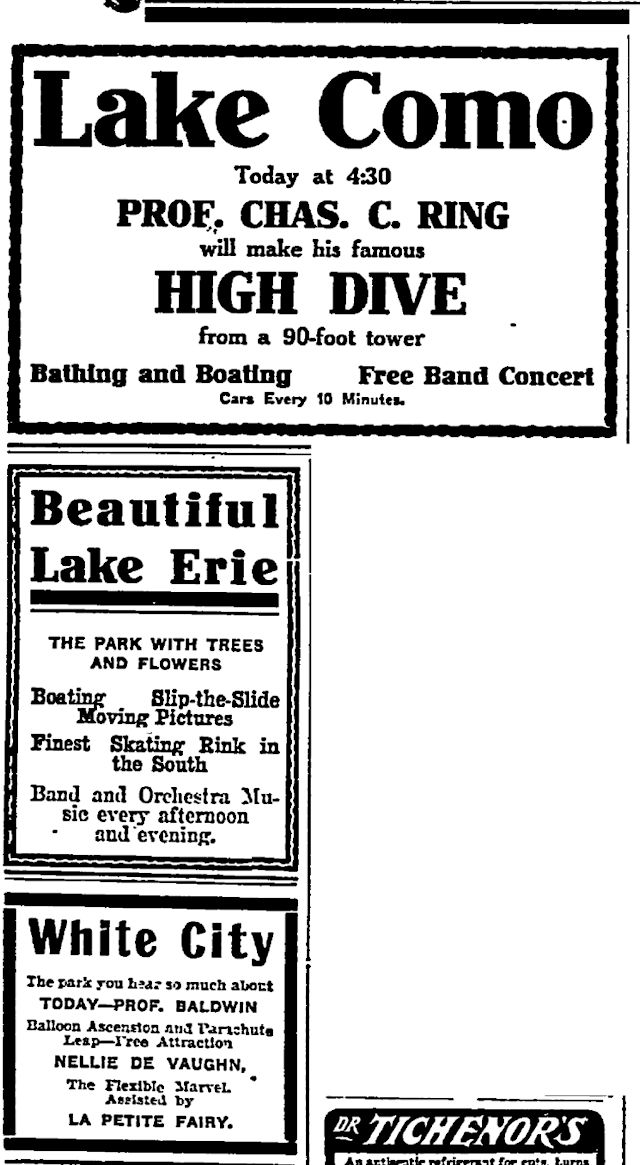 By 1906 ads for the other three trolley parks—Lake Como, Lake Erie, and White City—could be read on the same page of the Telegram, such as on August 5.
By 1906 ads for the other three trolley parks—Lake Como, Lake Erie, and White City—could be read on the same page of the Telegram, such as on August 5.
 Each year before summer the Telegram also published a preview of the three parks. Clip is from February 22, 1906.
Each year before summer the Telegram also published a preview of the three parks. Clip is from February 22, 1906.
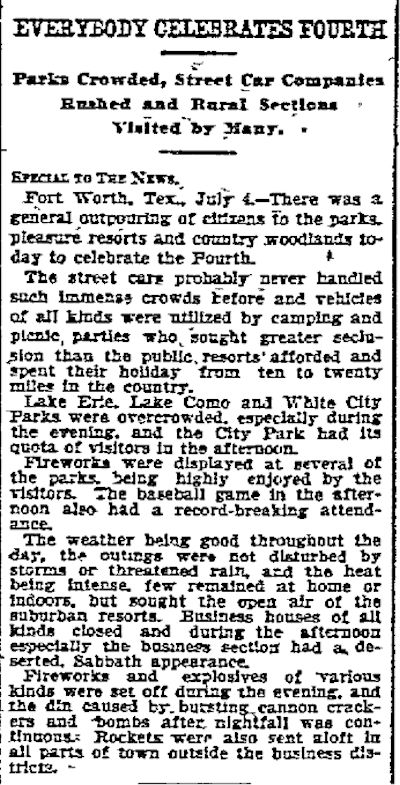 And each July 5 local newspapers printed a roundup of the Independence Day fun at the parks. Clip is from the 1908 Dallas Morning News.
And each July 5 local newspapers printed a roundup of the Independence Day fun at the parks. Clip is from the 1908 Dallas Morning News.
White City trolley park was part of Sam Rosen’s one-man economic tsunami on today’s North Side. In 1901 Fort Worth persuaded both Swift and Armour companies to build packing plants at the stockyards. Enter Sam Rosen. Rosen (1868-1932) had come to America from Russia at the age of twelve. He began his business career in Fort Worth modestly in 1882: as a peddler of tin goods and jewelry. By 1888 he had established a clothing store on Main Street downtown.
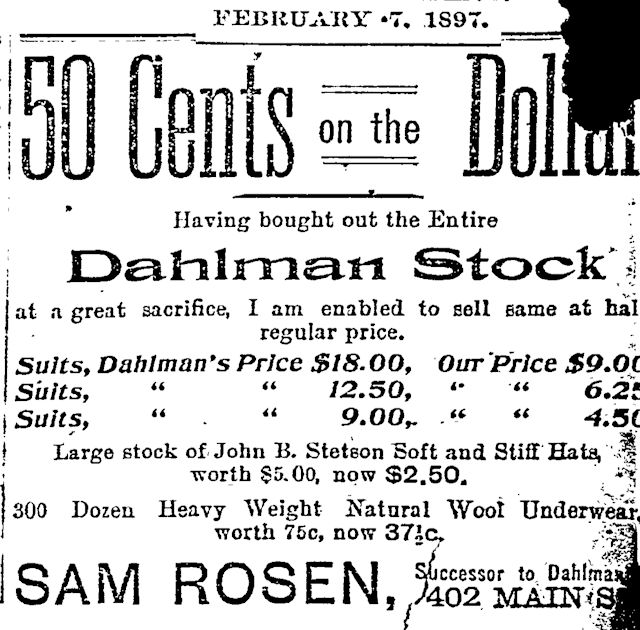
By 1897 his clothing store was at 402 Main Street.
All the while Rosen saved his money. Then, in 1901 Fort Worth negotiated with Swift and Armour to build meatpacking plants north of the river, So, Rosen bought hundreds of acres of farmland west of where the plants would be built and began to develop his Rosen Heights addition.
 In 1903 a homebuyer could get into a Sam Rosen house for a smidge under seventeen cents ($4 today) a day.
In 1903 a homebuyer could get into a Sam Rosen house for a smidge under seventeen cents ($4 today) a day.
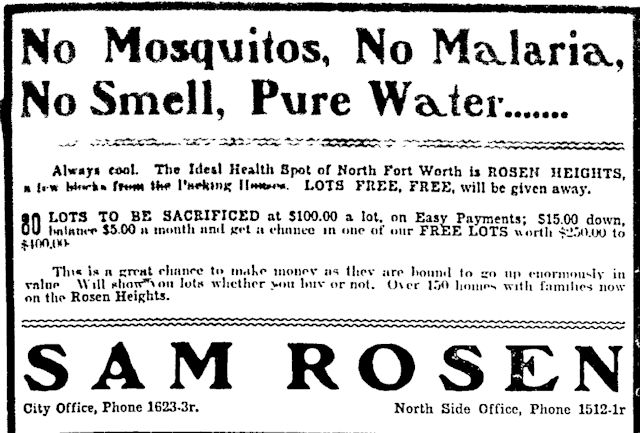 Rosen promised “no mosquitos, no malaria, no smell” in his subdivision. Ad is from the June 12, 1903 Telegram.
Rosen promised “no mosquitos, no malaria, no smell” in his subdivision. Ad is from the June 12, 1903 Telegram.
 Rosen provided his Rosen Heights homes with water and electricity. In 1903 he built his Rosen Heights streetcar line, which eventually ran to downtown Fort Worth. Then, to give all those new Rosen Heights homebuyers and streetcar passengers a place to go, in 1905 Sam Rosen decided to build an amusement park at the intersection of Northwest 24th and Grayson streets. (Photo from University of Texas at Arlington Libraries.)
Rosen provided his Rosen Heights homes with water and electricity. In 1903 he built his Rosen Heights streetcar line, which eventually ran to downtown Fort Worth. Then, to give all those new Rosen Heights homebuyers and streetcar passengers a place to go, in 1905 Sam Rosen decided to build an amusement park at the intersection of Northwest 24th and Grayson streets. (Photo from University of Texas at Arlington Libraries.)
 Rosen worked quickly, as people tended to do back then: no focus groups, public hearings, feasibility studies, impact statements. Just get ’er done! In December 1905 Rosen Heights Amusement Company announced plans to build “the most pretentious amusement playground that has been considered for any city in this state.” By the end of the month the company was chartered, and work was under way. In January 1906 a contract was let to dam water from nearby springs to form Lake Togo. In March work on the streetcar line to White City was almost complete. Clips are from the December 5, 1905, December 29, 1905, January 19, 1906, and March 31, 1906 Telegram.
Rosen worked quickly, as people tended to do back then: no focus groups, public hearings, feasibility studies, impact statements. Just get ’er done! In December 1905 Rosen Heights Amusement Company announced plans to build “the most pretentious amusement playground that has been considered for any city in this state.” By the end of the month the company was chartered, and work was under way. In January 1906 a contract was let to dam water from nearby springs to form Lake Togo. In March work on the streetcar line to White City was almost complete. Clips are from the December 5, 1905, December 29, 1905, January 19, 1906, and March 31, 1906 Telegram.
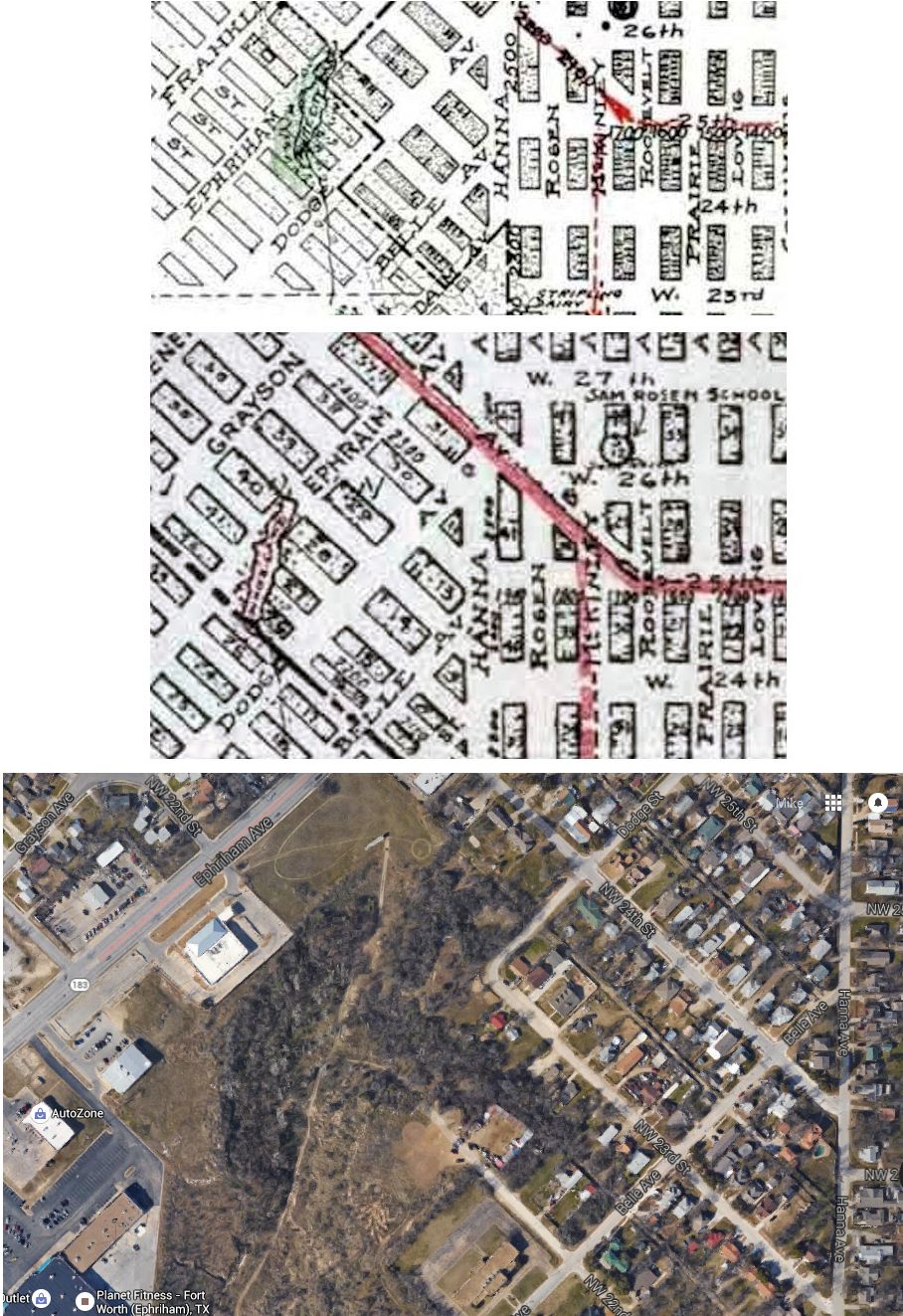 Maps from 1919 and 1925 show Lake Togo at the intersection of Ephriham Avenue and Northwest 24th Street. The contemporary aerial photo shows that location today. Lake Togo was to the right of the AutoZone store in the wooded area of low elevation fed by a creek flowing northeast. (Sanborn maps from Pete Charlton’s “1000+ Lost Antique Maps of Texas & the Southwest on DVD-ROM.”)
Maps from 1919 and 1925 show Lake Togo at the intersection of Ephriham Avenue and Northwest 24th Street. The contemporary aerial photo shows that location today. Lake Togo was to the right of the AutoZone store in the wooded area of low elevation fed by a creek flowing northeast. (Sanborn maps from Pete Charlton’s “1000+ Lost Antique Maps of Texas & the Southwest on DVD-ROM.”)
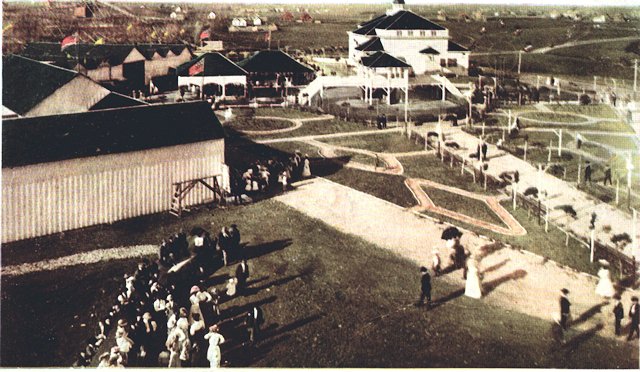 Sam Rosen’s White City opened on San Jacinto Day (April 21) in 1906. All of the park’s buildings were painted white, hence the park’s name: “White City Park.” White City offered patrons boating on Lake Togo, ball diamonds, a dance pavilion, and walkways. Amusement rides included a Ferris wheel, a circle swing, a helter skelter, and a figure-eight roller coaster—all under “brilliant” electric lights. Patrons could enjoy “high-class vaudeville,” “water baseball,” concerts, dramatic troupes, scenic tours, skating, Japanese polo, a penny arcade, and glass blowers. (Photo from Pete Charlton.)
Sam Rosen’s White City opened on San Jacinto Day (April 21) in 1906. All of the park’s buildings were painted white, hence the park’s name: “White City Park.” White City offered patrons boating on Lake Togo, ball diamonds, a dance pavilion, and walkways. Amusement rides included a Ferris wheel, a circle swing, a helter skelter, and a figure-eight roller coaster—all under “brilliant” electric lights. Patrons could enjoy “high-class vaudeville,” “water baseball,” concerts, dramatic troupes, scenic tours, skating, Japanese polo, a penny arcade, and glass blowers. (Photo from Pete Charlton.)
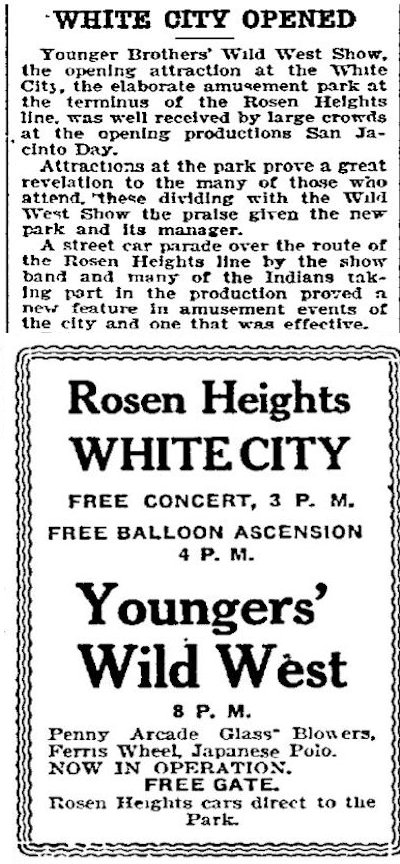 According to the Telegram of April 22 and 23, the opening acts of the new park included the Youngers’ Wild West show and a balloon ascension. The Younger referred to probably was outlaw Cole Younger, and the show may have featured outlaw Frank James. The two men had begun touring in a wild West show in 1903. (Note that White City management wisely scheduled the balloon ascension for 4 p.m., before Youngers’ Wild West show began throwing lead into the sky at 8 p.m.)
According to the Telegram of April 22 and 23, the opening acts of the new park included the Youngers’ Wild West show and a balloon ascension. The Younger referred to probably was outlaw Cole Younger, and the show may have featured outlaw Frank James. The two men had begun touring in a wild West show in 1903. (Note that White City management wisely scheduled the balloon ascension for 4 p.m., before Youngers’ Wild West show began throwing lead into the sky at 8 p.m.)
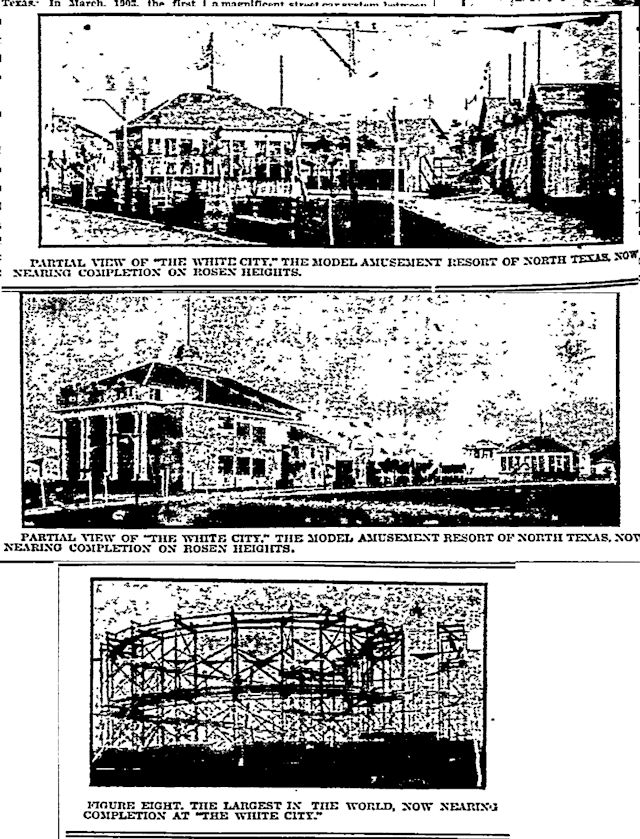 On May 9, 1906 the Telegram ran a spread on the new park, including these photos of “the model amusement resort.”
On May 9, 1906 the Telegram ran a spread on the new park, including these photos of “the model amusement resort.”
 On August 5, 1906 the Telegram announced that Minnie Crenshaw of Fort Worth, a pioneer female aerialist who performed nationally as “Nellie de Vaughn,” would ascend in a balloon and leap from a parachute. Four days later the Telegram would report Minnie Crenshaw’s suicide.
On August 5, 1906 the Telegram announced that Minnie Crenshaw of Fort Worth, a pioneer female aerialist who performed nationally as “Nellie de Vaughn,” would ascend in a balloon and leap from a parachute. Four days later the Telegram would report Minnie Crenshaw’s suicide.
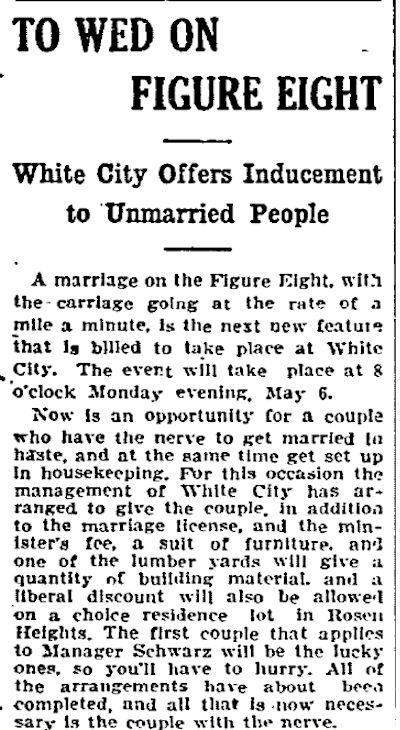 Sam Rosen didn’t miss many promotional chances. On April 26, 1907 the Telegram announced that a couple could be married on the figure-eight roller coaster at sixty miles per hour. After their feet were back on the ground, bride and groom would also receive a discount on a “choice residence lot” in Rosen Heights.
Sam Rosen didn’t miss many promotional chances. On April 26, 1907 the Telegram announced that a couple could be married on the figure-eight roller coaster at sixty miles per hour. After their feet were back on the ground, bride and groom would also receive a discount on a “choice residence lot” in Rosen Heights.
 On June 24, 1908 the Telegram reported that Confederate veterans holding a four-day encampment at White City would stage the sinking of the battleship Maine on Lake Togo (complete with fireworks) and a mock land battle against local militia members. The men had already reenacted the Battle of Little Bighorn. The Telegram said that the last streetcar would leave the war zone at midnight.
On June 24, 1908 the Telegram reported that Confederate veterans holding a four-day encampment at White City would stage the sinking of the battleship Maine on Lake Togo (complete with fireworks) and a mock land battle against local militia members. The men had already reenacted the Battle of Little Bighorn. The Telegram said that the last streetcar would leave the war zone at midnight.
 But on July 14, 1908 the Telegram reported that arson had destroyed about half of Sam Rosen’s park. Sam Rosen vowed to rebuild.
But on July 14, 1908 the Telegram reported that arson had destroyed about half of Sam Rosen’s park. Sam Rosen vowed to rebuild.
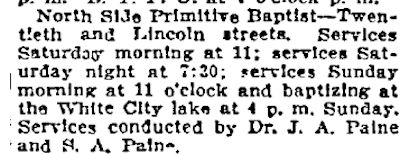 The 1908 fire hurt White City’s business. By 1910, as reported in the August 21 Star-Telegram, White City’s Lake Togo was being used by a neighborhood church for baptisms. By the 1930s the lake did not appear on maps.
The 1908 fire hurt White City’s business. By 1910, as reported in the August 21 Star-Telegram, White City’s Lake Togo was being used by a neighborhood church for baptisms. By the 1930s the lake did not appear on maps.
 White City was listed in the 1911 city directory, but the park closed about 1912.
White City was listed in the 1911 city directory, but the park closed about 1912.
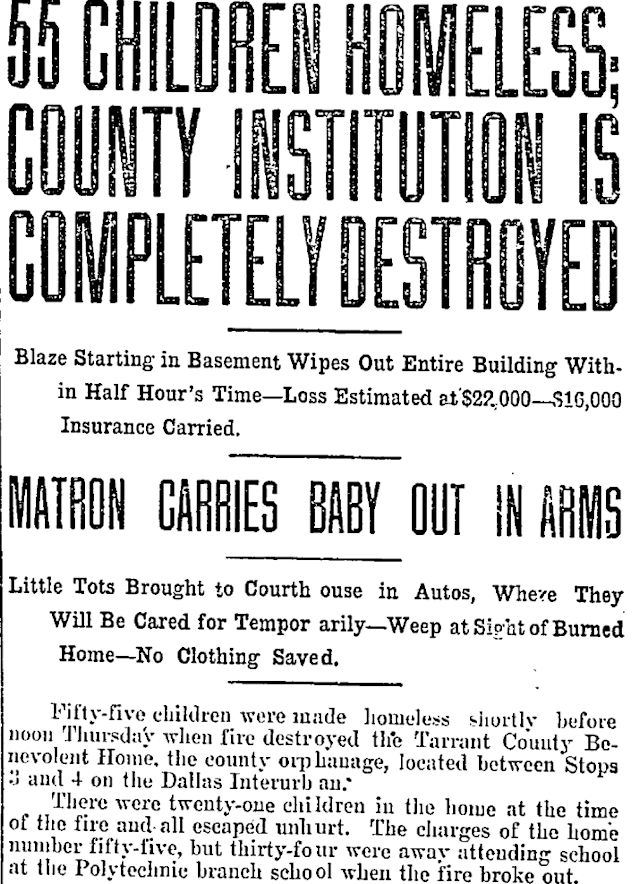 On March 19, 1914 the Star-Telegram reported that the county orphanage on the East Side had burned.
On March 19, 1914 the Star-Telegram reported that the county orphanage on the East Side had burned.
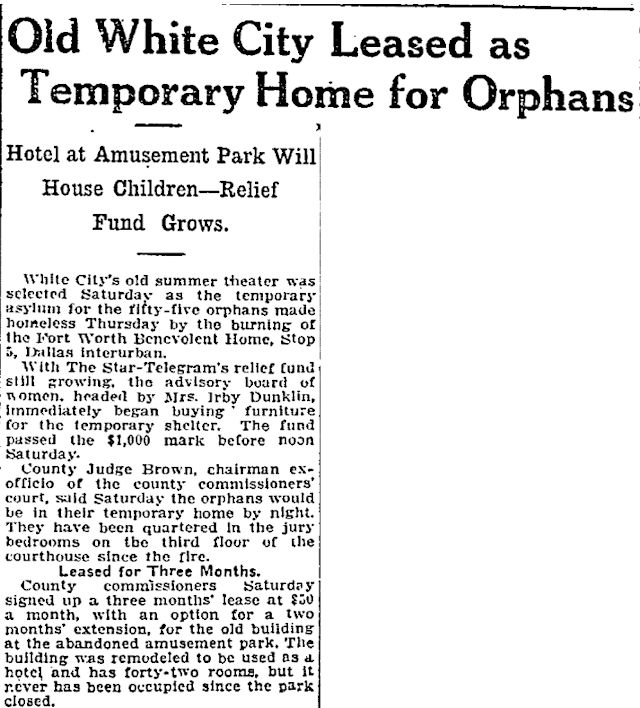 Two days later, on March 21, 1914, the Star-Telegram reported that the “abandoned amusement park” would be a temporary home for the orphans.
Two days later, on March 21, 1914, the Star-Telegram reported that the “abandoned amusement park” would be a temporary home for the orphans.
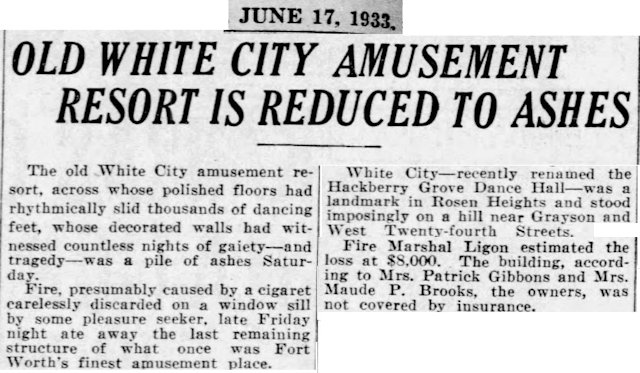 By 1933 only the dance pavilion of White City survived. It had recently reopened with a new name: “Hackberry Grove Dance Hall.” Fire destroyed the last vestige of “the model amusement resort.”
By 1933 only the dance pavilion of White City survived. It had recently reopened with a new name: “Hackberry Grove Dance Hall.” Fire destroyed the last vestige of “the model amusement resort.”
The two surviving trolley parks—Como and Erie—suffered when the city of Fort Worth built Lake Worth in 1913 and in 1917 opened a municipal beach there.
Of course, the streetcar and interurban companies also suffered as automobiles and buses increasingly competed with them. As the streetcar and interurban companies reached the end of the line, so did the trolley parks.






very interested in Lake Togo , White city…me 61 grew up playing on the dam of that lake…spoke to old girlfriend , whose father 92 remembers it…my Mom told me about it…when was the dam breached? No lake there in 1952 according to NETR historic aerials…
Thorne Williams NSHS ’72
Thorne, I do not know when the dam was breached, but by the 1930s the lake was not on maps. But it still showed in 1925. I have added some images to the blog post to show the park/lake location then and the contemporary location.